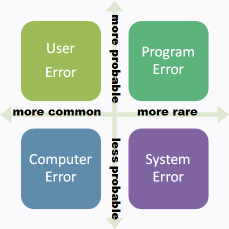4.2 Basic Troubleshooting
Troubleshooting is a logical and systematic search for the source of a problem. Following the steps helps ensure you approach all problems with clear logic, eliminating more common errors before beginning more complex investigations.
A timely diagnosis and a thorough write up of the issues generally leads to a quicker resolution of the problem.
Note: In most cases, you will not be asked to resolve any of these problems by yourself. Knowing about different types of errors will help with the troubleshooting process.
 Working from Common to Rare Possibilities
Working from Common to Rare Possibilities
Identify and isolate the issue as a first step.
Start with the most probable and common issue, and progress to the least probable and uncommon issue. Consider the chart on the right.
If you have not seen this type of behavior previously, you should move from left to right and then top to bottom when searching for errors (User, Program, Computer, and System).
You may need to troubleshoot several types of errors - user, computer, system, and program errors. Here are some tips for identifying various types of errors.
User errors are the most common and probable issues. Typical user errors include incorrectly typing commands or not clicking the right part of a menu.
Computer errors typically occur on only one workstation. Make sure you are on a workstation configured with a calibration Stand Alone instance.
System errors are more widespread than user and computer errors, occurring on more than one calibration-configured workstation.
Program errors tend to occur after software upgrades. Like most software, CHPS is updated periodically.

